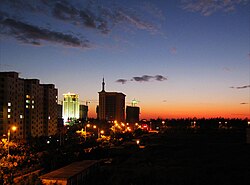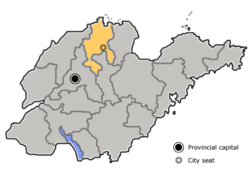Binzhou
|
Binzhou 滨州市 |
|
|---|---|
| Prefecture-level city | |
 |
|
 |
|
| Location in China | |
| Coordinates: 37°22′N 118°01′E / 37.367°N 118.017°ECoordinates: 37°22′N 118°01′E / 37.367°N 118.017°E | |
| Country | People's Republic of China |
| Province | Shandong |
| County-level divisions | 7 |
| Municipal seat |
Bincheng District (37°22′N 118°0′E / 37.367°N 118.000°E) |
| Government | |
| • CPC Secretary | Sun Dehan (孙德汉) |
| • Mayor | An Shiyin (安世银) |
| Area | |
| • Total | 9,444.65 km2 (3,646.60 sq mi) |
| Elevation | 20 m (70 ft) |
| Population (2010) | |
| • Total | 3,779,200 |
| • Density | 400/km2 (1,000/sq mi) |
| Time zone | China Standard (UTC+8) |
| Postal code | 256600 |
| Area code(s) | 0543 |
| License Plate Prefix | 鲁M |
| Binzhou | |||||||||
| Traditional Chinese | |||||||||
|---|---|---|---|---|---|---|---|---|---|
| Simplified Chinese | |||||||||
| Literal meaning | Coastal Prefectural Capital | ||||||||
|
|||||||||
| Transcriptions | |
|---|---|
| Standard Mandarin | |
| Hanyu Pinyin | Bīnzhōu |
| Wade–Giles | Pin-chou |
| Former names | |||||||||

Putai, south of the Yellow River in 1878
|
|||||||||
| Putai | |||||||||
|---|---|---|---|---|---|---|---|---|---|
| Traditional Chinese | |||||||||
| Simplified Chinese | |||||||||
| Literal meaning | Pu Terrace | ||||||||
|
|||||||||
| Transcriptions | |
|---|---|
| Standard Mandarin | |
| Hanyu Pinyin | Pútái |
| Wade–Giles | P‘u-t‘ai |
Binzhou, formerly Putai, is a prefecture-level city in northern Shandong Province in the People's Republic of China. The city proper sits on the northern bank of the Yellow River, while its administrative area straddles both sides of its lower course before its present delta.
Human settlement dates to at least the Chinese Neolithic. During the Shang, the area around Binzhou was held by the Pugu, who were counted among the "Eastern Barbarians" or Dongyi. Pugu joined the Shang prince Wu Geng's failed rebellion against the Zhou and was destroyed c. 1039, with its lands given to the minister Jiang Ziya as the march of Qi. The Bamboo Annals suggest the Pugu continued to trouble the Zhou for another decade and state they were again destroyed c. 1026. Qi became one of the most power of China's Warring States but was ruled from Yingqiu (modern Zibo), except for a brief hiatus under Duke Hu. He relocated to Bogu but was overcome by the revolting people of Yingqiu; his successor restored the former capital.
...
Wikipedia

